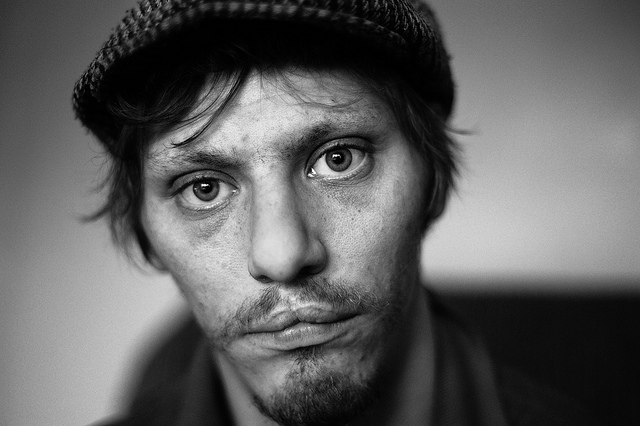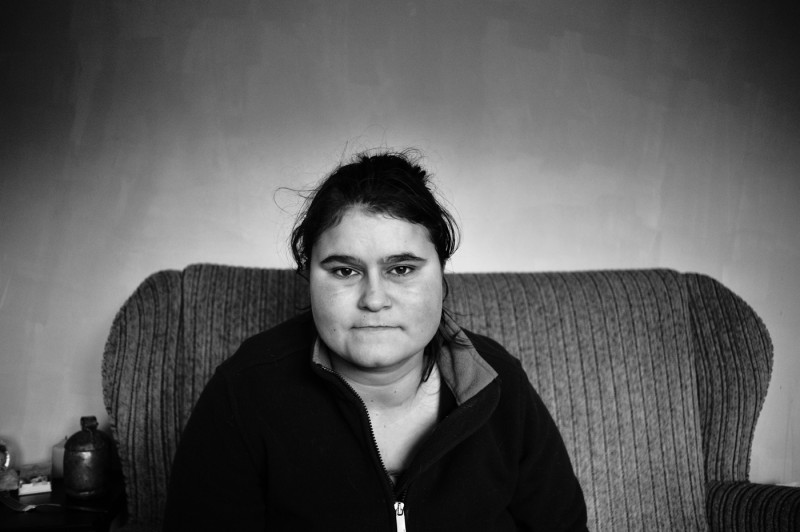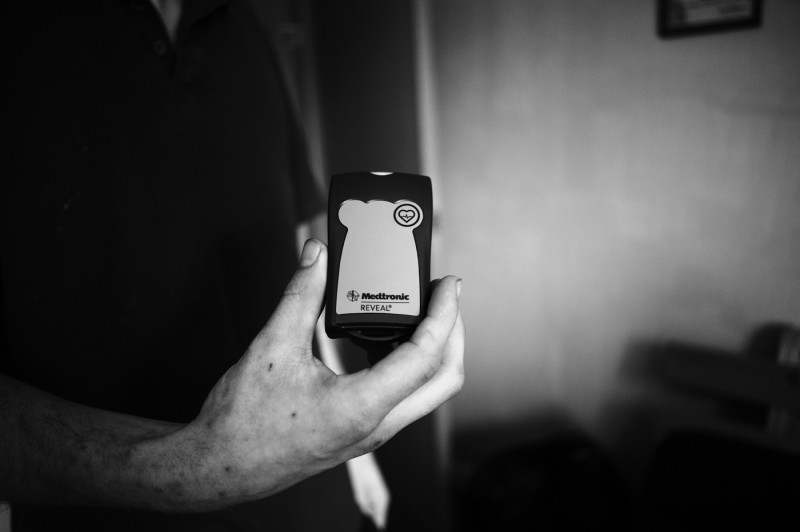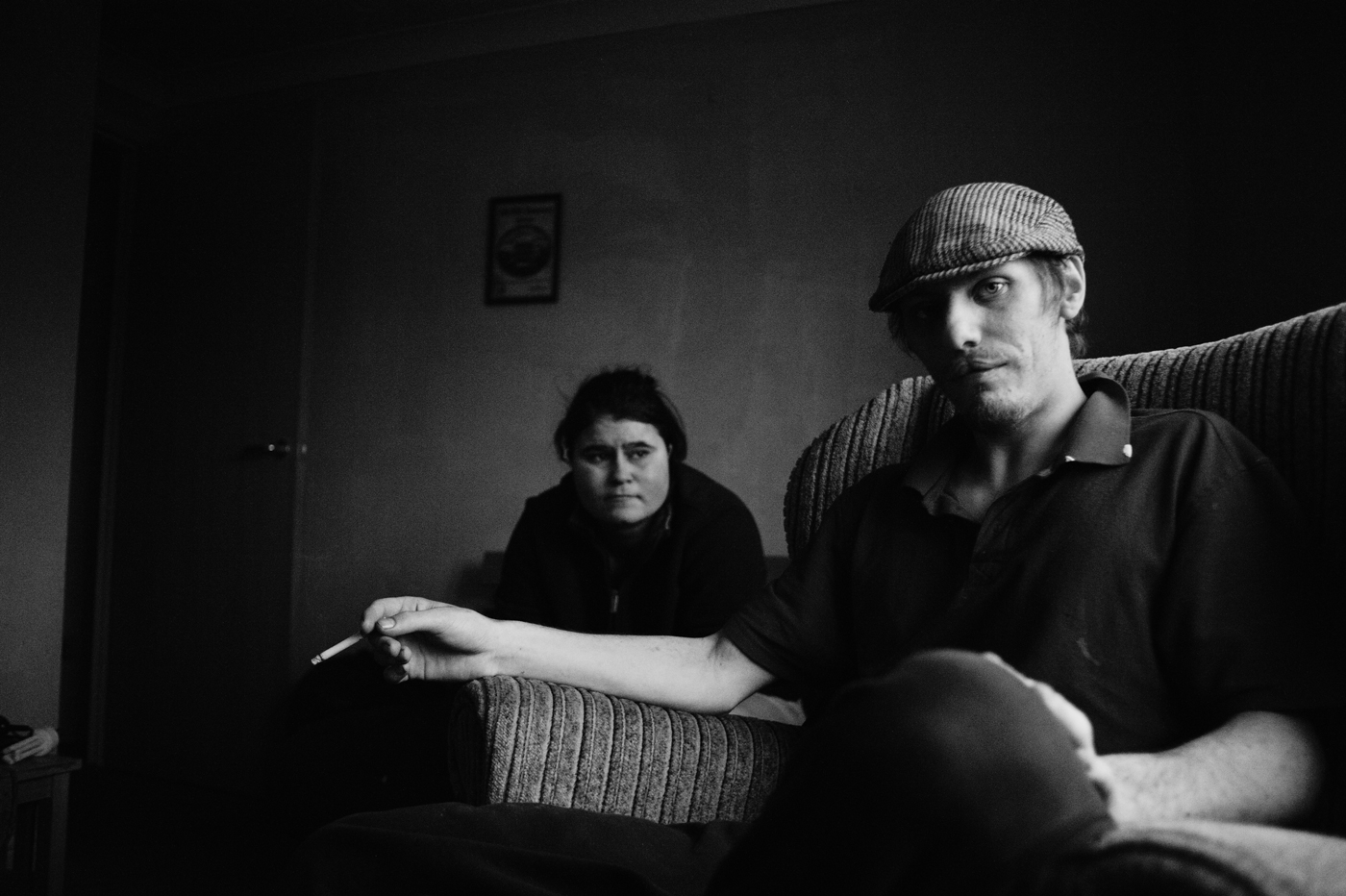More than words
Written by duckrabbitOne of the most silly things that gets batted about in the photography world is the belief that ‘a great photo needs no explanation’.
It’s as daft as saying a film is only great if it works without a soundtrack.
That’s not to say that photos can’t be great in their own right. To deny that would be equally daft, but often the words are just as important as the pictures.
I think photojournalism would have a deeper reach if more photographers worked as hard at the words that go with the pictures as the pictures themselves. We’d be talking about, and celebrating, compelling stories, as opposed to brilliantly composed pictures. We’d consistently come away knowing much more about the people in the pictures than the skills of the photographer. If we’re really interested in journalism than surely anything else is a failure?
Here are some words that can be found accompanying Marcus Bleasdale’s celebrated pictures in an advertorial film by CANON:
‘My names Marcus Bleasdale and I’m a photographer. The work that I focus on mostly is trying to document the effects of conflict on population… I work a lot with human rights organisations about how that conflict manifests itself into human rights abuses and my camera of choice is the Canon 5d Mark2 .. For me the lens is everything. Its all about the optics’.
You probably think I made that quote up. I wish I had:
Is this how you need to make money as a photojournalist? Traveling to conflict zones to shoot populations (a word that Bleasdale repeats in this film as opposed to ‘people’), taking pictures which at some point you can flog with a story about yourself roughing up your camera to CANON?
All my experience tells me that the depth of the relationship you form with the people that you photograph, or interview, will directly determine what your conscience will allow you to do with the images, and what story you are prepared to sell.
A few months back I came across, and wrote about, the photography of Jim Mortram suggesting that his work ‘Market Towns’ is one of the great British photographic projects of our time. (the most shared post in duckrabbit’s history).
Some regular readers will have been surprised by this statement because his photography so squarely sits in great black and white documentary tradition, something at times I have derided. Let me be clear it’s not the black and white photography that offends me, but when a blunt aesthetic is used to hide the shallowness of the storytelling (and we all run around applauding).
In Jim’s case it’s not his photos then that draw me in so deeply, but the way they dance with his words, telling me something about the people in the pictures in a way that few photographers can get close to.
I’ll rest my case by re-publishing a recent post from Mortram’s newly conceived blog. Essential.
Market Town : Simon & Kirsty : Living with Epilepsy
‘If I’m away working for the day all I can think of is Kirsty, if she’s had a fit or fallen.
She’s fallen into the bath before when it was filled with water, thankfully I was home.
She’s had fit’s in bed at night, I wake up covered in bruises.
We’ve been out, dancing but the lights have caused a seizure and I turn around and she’s on the floor.
I’ve had fights, a lot … people say things, nasty things.
I’ve been told to put her in a home.
I’ve come home sometimes from work, Kirsty had a fit whilst I was away and she’s not been here, they took her to a Hospice.
She didn’t know anything about it. I was terrified.
I’d never put her away though, she’s my wife, I love her. The only place she’s going is right here, home. Our home.’
Still considered an ‘Orphan disease’, Epilepsy affects only a small percentage of the population and can still hold a powerful social social stigma. It’s often misunderstood, kept secret and judged negatively both historically and contemporarily.
Personally I’ve had experience of Epilepsy all of my life, my Mother was diagnosed with the condition at birth and I’ve been her full time Carer since 1994. Growing up in close proximity to an illness rendered it’s power, mystery and stigma mute for me. It’s always been a part of my families life. It’s a part of our everyday.
Seeing the effects of acute Grand Mal Epilepsy where the brain, body and emotions can endure severe symptoms and trauma, listening to stories of treatment in the 1950’s and 60’s, witnessing treatment over the last 20 years and seeing, first hand, societies fears and sometime loathing of a disease often so cruel to those affected prompted my desire to document how people deal and live today with the condition.
Tracking down local members of my community that live with Epilepsy was something I at first found daunting. The how’s and where’s were answered quickly as I asked around the wonderful network of people that I document. It’s a small town, people know people and a week after sending word out I had a list of names and places and I began with a first meeting with Simon and Kirsty.
Simon’s responsibilities are huge. He work’s every hour manageable and is Kirsty’s sole unpaid Carer.
Simon’s Father left ‘When I was very young, he’s in America now.’ A frequent runaway, sometimes homeless from the age of 15 ‘Always running away from my problems.’ he’s taken direct steps to ‘Do the right thing’ since meeting and marrying Kirsty. In recent years he was the principle carer, again unpaid, for his Mother whom had been diagnosed with liver cancer in addition to caring for Kirsty. This February is the first anniversary of Simon’s mothers passing.
Kirsty has Nocturnal Epilepsy, seizures that most often occur during sleep and frequent Petit Mal seizures and occasional Grand Mal seizures. Her Mother passed away when Kirtsy was 2. Simon explains ‘She had Epilepsy too, she drowned in the bath. We don’t lock the bathroom door here. Ever.‘
Kirsty was also born with Tetralogy of Falot. A heart condition that causes an inadequate blood flow to the lungs for oxygenation. She has been fitted with an implantable loop recorder, a small device that measures incidents of syncope, most commonly known as fainting.
The Loop recorder that Simon records activty of the heart with before, during and after loss of Kirsty’s consciousness.
There’s an evident state of teamwork and togetherness to Simon and Kirtsy. Love is evident. As are the hardships endured. Kirsty’s currently not taking any medication for her Epilepsy and the Carers that used to visit now no longer do.
Simon’s responsible for everything.





Discussion (16 Comments)
HAH, The canon video is reminiscent of this http://vimeo.com/37168265 parody.
I can only repeat what I posted on Jim’s blog a week or so ago:
“Another powerful set Jim. Real trust in these faces. Small town, big people.
I hope lots of folk view this page and see these images, and more importantly I hope they take the time to read the words and consider the story of the lives behind them.
Too much of the stuff I see online is all surface and no depth. No such problem here.
Well done, and most important of all – thanks to Simon and Kirsty for letting us have such an insight into their lives.”
The piece of equipment that’s key to producing this excellent work? Three inches behind the camera.
Yes – a powerful set and eloquently moving. There are so many unsung heroes and heroines living unseen lives and caring with such devotion. I think this type of work is so important in rederessing the balance.
Jim’s project is really great…and I couldn’t agree more re the relationship between words (be it text or audio) and images. When I was writing my MA report I found a couple of quotes which resonated with me and how I think about my work, which plays on the relationship between the two elements.
>>
The meaning of any photograph is elastic and may slip with time or when an image is viewed in different cultural contexts. Intelligent use of captions may help, since meaning arguably rests in the interplay of image and words. As Start Hall puts it: “Two discourses – the discourse of written language and the discourse of photography – are required to produce and ‘fix’ the meaning”.
and
AD Coleman goes as far as to say that re-establishing “the essential relationship to text” – be it first-person testimony, historical background or something other – is one way documentary and photojournalism could regain its social relevance. “[This] is the most effective means for contextualising visual imagery, empowering its human subjects by giving them a voice, drawing generalisations from the photograph’s particulars,” he writes.
Thanks Ciara … actually I was also thinking about your work too when I was writing this post … your relationship between the people you photograph (I know they are people not subjects to you) and the words you write.
Thank you John, Catherine and of course all at Duckrabbit. Much appreciated by both myself and the people within the images and stories.
Thanks Ciara, much appreciated.
Speaking for myself, the reason I add text and testimony is out of respect for the people and lives within the images. Being permitted to enter another persons life to listen and make images, it would be a huge breach of trust to then share images out of context, with no back story.
Leaving the images in a void, open for any interpretation would for me, be pointless. It would also strip the people I photograph from any sense of empowerment resulting from the act of collaborating in the photographs, the very process is I feel in many ways a catharsis at times, a place to confront and expel moments and memories, even for the briefest of moments that otherwise may be left un noticed and un shared forever.
I’m not attempting, nor would I desire to make art from peoples lives, just to hold a mirror up and share the resulting reflection with the world outside. That act of sharing and informing, non judgementally and without imparting or forcing my own stylized version, visually, is at the heart of what I understand Social Documentary work to be.
It is all about the act of sharing. And that shows right through the process.
On Marcus – it’s his thing, and the words — well it’s the blather that sells cameras. It doesn’t mean that I don’t think his work has value. However I also think that the photojournalist stuff has become over romanticized by some. If some knew the real life… At times it’s “hurry up and wait”. And it’s a tough life in many ways, not always the stuff you see in the movies.
Real people – now there’s a challenge. Some are not up to it. And some can’t see the value in digging deep to find some compelling aspect in the life of the average Joe. Everybody’s got a story. Are we brave enough to go out and find them?
I can agree with the first four paragraphs. And J A Mortram’s work is excellent. However….
Yes, he really does say this (or something very much like it). But the way you use this is unfair.
Of course the equipment the photographer uses is not so important. I’m sure that both Mortram and Bleasdale can get more worthwhile results out of a Holga than I could out of Canon’s most expensive DSLR. Some photographers don’t choose their equipment but most do. If you are going to take photographs somewhere like the Congo, you’d be nuts not to think carefully beforehand. Bleasdale does think, and for him it’s a matter of size, weight, reliability. It’s this that’s the context for his remark For me the lens is everything. It’s all about the optics. Not “When I judge a photo, the lens is everything”, not “When I wonder what photo story to embark on, the lens is everything”, but instead something like “When I decide what to chuck into my camera bag, the lens is everything.” An idea with which you or I may disagree, but which to me doesn’t sound at all crass.
(And yes, he does say “population” when “people” would have sounded better — perhaps a kind of slip of the tongue. Strange that the ad agency that made this video for Canon didn’t notice this and have him redo that part. But if it all had been note-perfect, people might knock it for its slickness.)
And then:
No, as a photojournalist he doesn’t need to do this. He could devote his working hours to the documentation of teevee, film or sporting celebs. (There are surely yet more careers to be made photographing the royals or the Beckhams: their hairstyles, their frocks, their horses or other toys, their houses, their progeny.) Yes, that’s one extreme of vapidity, and surely there are other, less grotesque ways to eke out a living closer to home. But far away?
I’m all in favour of documentary work (slow journalism) about people whose languages I don’t speak living in places that aren’t a direct flight from either Narita (my airport) or Heathrow (perhaps yours). I’ve bought photobooks of this work, etc. But the economics of it are tough. Perhaps the best known example is the Sochi Project. All power to this (and my subscription too!), but I think it’s struggling. I don’t know much about Bleasdale’s work, but he seems to be doing “fast journalism” in Africa. I might wish it were slow journalism instead, and fast journalism can indeed exacerbate prejudices, but on balance (and after reading and thinking about Susie Linfield’s The Cruel Radiance) I warmly support the photography of atrocities and their aftermath, wherever these atrocities occur.
Oh, certainly I wish that the news media had more of an appetite for this work, pairing it with intelligently written text. But they don’t have much of an appetite (not least because the viewing/reading population prefers feelgood stuff, celeb piffle, etc). And certainly the “art” market doesn’t salivate over this kind of material either.
So, given that you’re photographing goings-on in nations that most people would prefer to ignore, how do you make ends meet? Do you have to supplement your income with advertising revenue from the camera manufacturer? I don’t claim to know, but I’d guess that you do have to supplement it somehow. Do you have any better suggestions for Bleasdale?
HI Microcord,
great comment. Lots of important questions. I’ll respond properly when I get a chance!
THANKS
Bleasedale may be making a few bucks from Canon, and he may be making a few for them- but for Chrissakes, I would by now hope some camera company got Jim Mortram the camera and modicum of equipment he needs to keep creating work the quality of which is seldom seen! And I certainly hope he’s applying for a few grants, and that those that give ’em out know talent when it jumps their way…
Wah Wah Wah
Hi foolonhill,
This is no place for Captain Haddock impersonators (or anonymous trolls)
Microcord, Stan B. Thanks very much.
I’ll leave a longer comment later but now, work! I got no grant nor response from any camera company though I did raise the money for a second hand camera by selling my prints and donations from fellow photographers, there is a tight community of photographers out there and I’m pretty honoured to have been taken under their wing, so to say.
As I am not a professional, nor make any money from doing what I do and am unlikely to ever be offered a job working in the style I do their support really facilitates all the projects I work on and for that I am more than thankful.
The real debt, for me at least is to the people in the photographs I make, as I always at some point say to them, without your trust and honesty and allowing me into your life all I’d be taking a photograph of is a blank wall and my camera would most likely be nothing more than a paperweight.
Having the right equipment does enable more shots, I know getting my own camera has allowed me to shoot more in the low light that I always shoot in but that’s not the be and end all of getting ‘good’ work. Canon can’t sell you how to listen and Nikon can’t sell you how to commit to an idea.
Quote: “Canon can’t sell you how to listen and Nikon can’t sell you how to commit to an idea.”
This comment should be pasted on the wall of every building running a PJ course, and in every place photographers congregate…………..